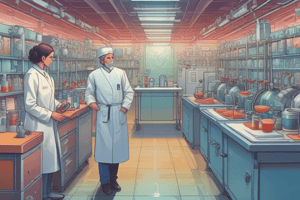Podcast
Questions and Answers
Which of the following is a key mechanism by which heat sterilization damages microorganisms?
Which of the following is a key mechanism by which heat sterilization damages microorganisms?
- Inhibition of ribosome function
- DNA fragmentation
- Coagulation of proteins and enzymes (correct)
- Disruption of cell membranes
Why is moist heat sterilization generally more effective than dry heat sterilization?
Why is moist heat sterilization generally more effective than dry heat sterilization?
- The presence of water lowers the heat resistance of microorganisms (correct)
- Moist heat uses radiation to kill microorganisms
- Moist heat operates at higher temperatures
- Moist heat is more easily controlled
Which of the following is an advantage of dry heat sterilization over moist heat sterilization?
Which of the following is an advantage of dry heat sterilization over moist heat sterilization?
- Suitability for sterilizing oily materials and powders
- Faster sterilization times
- More effective at killing spores (correct)
- Lower temperature requirements
Which of the following sterilization methods is best suited for sterilizing metal objects using a direct flame until red?
Which of the following sterilization methods is best suited for sterilizing metal objects using a direct flame until red?
What is the primary purpose of using a fan in a hot air oven for sterilization?
What is the primary purpose of using a fan in a hot air oven for sterilization?
During the loading of a hot air oven, why should poor conducting materials be distributed in small quantities?
During the loading of a hot air oven, why should poor conducting materials be distributed in small quantities?
Why should large articles in a hot air oven be placed away from the walls?
Why should large articles in a hot air oven be placed away from the walls?
Why is superheated steam not considered suitable for effective heat sterilization?
Why is superheated steam not considered suitable for effective heat sterilization?
What is a key factor that can cause the formation of superheated steam in an autoclave?
What is a key factor that can cause the formation of superheated steam in an autoclave?
Why is it important to remove air from a steam sterilizer?
Why is it important to remove air from a steam sterilizer?
Flashcards
Heat sterilization
Heat sterilization
Sterilization method using heat to kill microorganisms.
Dry heat sterilization
Dry heat sterilization
Type of heat sterilization using high temperatures without water.
Red heat sterilization
Red heat sterilization
Sterilization method using direct application of flame until the object glows red.
Hot air oven
Hot air oven
Signup and view all the flashcards
Moist heat sterilization
Moist heat sterilization
Signup and view all the flashcards
Saturated steam
Saturated steam
Signup and view all the flashcards
Convection
Convection
Signup and view all the flashcards
Infrared radiation
Infrared radiation
Signup and view all the flashcards
Tyndallization
Tyndallization
Signup and view all the flashcards
Pasteurization
Pasteurization
Signup and view all the flashcards
Study Notes
- Sterilization methods are divided into Physical and Chemical Methods
- Physical methods use heat, radiation, or filtration to kill or remove microorganisms
- Chemical methods use liquids or gases to kill microorganisms
Heat Sterilization
- Heat sterilization damages microorganisms by coagulating their proteins and enzymes
- Hydrated microorganisms are less resistant to heat, needing less exposure time compared to dehydrated microorganisms
Dry Heat Sterilization
- Dry heat sterilization is performed without water
- Dry heat requires a temperature of 160°C for 1-4 hours
- Dry heat is suitable for materials damaged by moisture, like oily substances and powders
- Dry heat is suitable for glassware and metals due to no corrosion
Moist Heat Sterilization
- Moist heat sterilization is performed in the presence of steam
- Moist heat uses lower temperatures (115-134°C) for shorter durations (2-30 minutes)
- Moist heat is unsuitable for thermolabile materials due to heat sensitivity
Dry Heat vs. Moist Heat
- Dry heat requires drastic conditions (high temperature and long time)
- Moist heat offers better mobility and penetration due to steam
Methods of Dry Heat Sterilization
- Red heat involves sterilizing metal objects by heating until they glow red
- Flaming involves passing objects through a flame
- Incineration is burning waste products and is not considered a sterilization method as it damages the product
- Hot air ovens are commonly used and have a fan for air circulation and temperature distribution
- Heat transfer in hot air ovens occurs through conduction, convection, and radiation
Sterilization Cycle Steps
- The sterilization cycle involves heating, holding at the recommended temperature for a specified time, and then cooling before removal
Loading Hot Air Ovens
- Proper loading optimizes heat transfer
- Poor conducting materials should be distributed in small quantities
- Powders should be placed in trays to increase surface area
- Loading should not hinder air circulation
- Large articles should be kept away from the oven walls to prevent blocking radiation
Other Dry Heat Methods
- Conducted heat sterilizers are used for glass syringes
- Infrared conveyor ovens use radiation for heating
- Infrared vacuum ovens are unsuitable for large instruments
Applications of Dry Heat
- Dry heat is suitable for glassware, metals, and porcelain
- It is used for anhydrous liquids like glycerol, phenol, oil, and vaseline
Sterilization with Moist Heat (Autoclaving)
- Moist heat uses steam under pressure as a sterilizing agent through autoclaving
- Steam should provide sufficient moisture and heat, using saturated steam, which is steam in equilibrium with water
- Saturated steam's latent heat is 560 calories to convert 1 gram of H2O at 100°C to steam at 100°C
Superheated Steam
- In the presence of water, superheated steam does not form because excess heat converts more water to steam
- Superheated steam is unsuitable for heat sterilization as it acts as a heat source but lacks moisture and functions as dry heat
Factors Causing Superheated Steam Formation
- Exhaustion of H2O from a portable autoclave
- Presence of air in the autoclave
- Pressure drop
Saturated and Superheated Steam
- Saturated steam has many advantages
- Condensation upon contact with cooler items releases latent heat of condensation for rapid heating
- Contraction of large steam volumes to smaller liquid volumes creates vacuum, improving penetration and heat distribution
- Use of saturated steam decreases dehydration of material
Steam Characteristics
- Saturated steam exists in equilibrium with water, easily condenses, releases latent heat, provides moisture, and ensures good penetration
- Wet steam carries droplets of H2O
- Dry steam does not contain droplets of H2O and is used in industrial and hospital sterilizers
Steam Sterilizers
- Steam under pressure sterilizers contain the following
- Give wet steam
- Are pressure controlled
- Are temperature controlled
- Contain three controls on the upper side of the lid
- Lid carries short thermometer, vent valve, safety valve, pressure gauge
Removal of Air in Autoclaves
- Air must be removed from sterilizers via mass flow dilution, gravity displacement, pressure pulsing, or vacuum
- Air removal is important because it hinders steam penetration and causes superheating
Autoclave Types
- Portable autoclaves provide wet steam
- Stationary autoclaves are large sterilizers with more complex designs for surgical dressings and bottled fluids
- Superheated water spray autoclaves for plastic containers use cooling water and avoid thermal shock and pressure shock
- Steam/air mixture autoclaves, for plastic containers of PVC
- Cooling is accomplished by sterile compressed air
Suitable Materials for Steam Sterilization
- Materials should be heat and moisture stable, and able to be penetrated by steam or contain moisture inside
Applications of Steam Sterilization
- Thermostable aqueous solutions in closed containers, such as eye drops, injections, and large volume parenterals
- Rubber materials, surgical dressings, and cotton
Moist Heat Sterilization Methods
- Heating with bactericide involves heating at 98-100°C with a bactericide like chlorocresol or phenyl Hg nitrate
- Boiling at 100°C for 5-10 minutes promotes killing through the addition of acid or alkali, like sodium carbonate
- Steaming is performed at 100°C for 30 minutes
Tyndallization
- Tyndallization (batch sterilization) are used exclusively for sterilizing culture media
- They involve three successive days of heating to 100°C for thirty minutes
Pasteurization
- Pasteurization does not kill spores, but it is able to kill bacteria with heat
- The holding method involves heat at 61.7°C for 30 minutes
- The flash method involves heat at 71.1°C for 15 seconds using High-Temperature Short-Time (HTST) pasteurization
Other Moist Heat Methods
- Sterilization of serum or body fluids (vaccine bath) involves heating at 56°C for 1 hour over several successive days
- Inspissation involves the use of serum or egg media heated at 80°C in an inspissator
- Sterilization of vaccines involves heating at 56°C for 30 minutes, chosen to reduce the antigenicity of the vaccine
Studying That Suits You
Use AI to generate personalized quizzes and flashcards to suit your learning preferences.
Related Documents
Description
Explore sterilization methods, divided into physical and chemical approaches. Physical methods employ heat, radiation, or filtration. Chemical methods use liquids or gases to eradicate microorganisms, ensuring effective sterilization.




